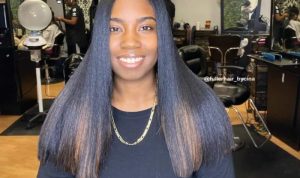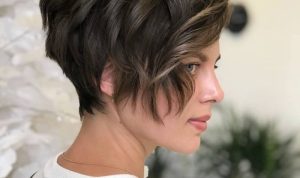Understanding Thin Hair
Hairstyles for very thin hair – Thin hair, a common concern, encompasses various types and causes. Understanding these factors is crucial for selecting appropriate hairstyles and care routines. This section will clarify the differences between fine, thin, and sparse hair, explore common causes, and explain how hair texture and density influence hairstyle choices.
Types of Thin Hair
The terms “fine,” “thin,” and “sparse” are often used interchangeably, but they represent distinct characteristics. Fine hair refers to the individual hair strand’s diameter; fine hair strands are smaller in diameter than medium or thick hair strands. Thin hair describes the overall density or number of hair strands on the scalp, regardless of individual strand thickness. Sparse hair signifies a significantly low number of hair follicles, resulting in visibly less hair coverage.
Someone can have fine hair that is also thin, or thick hair that is sparse.
Causes of Thin Hair, Hairstyles for very thin hair

Source: themodestman.com
Several factors contribute to thin hair. Genetics play a significant role, determining hair follicle size and density. Hormonal changes, particularly during pregnancy, menopause, or due to underlying medical conditions, can also impact hair thickness. Nutritional deficiencies, particularly in protein and iron, can weaken hair and contribute to hair loss. Stress, certain medications, and aggressive hair styling practices are additional contributing factors.
Finding the right hairstyle can be challenging, especially with very thin hair. Volume is key, often achieved through shorter cuts and strategic layering. However, understanding texture is also crucial; if frizz is a concern, consider researching options that manage it effectively, perhaps consulting a guide like what is the best hairstyle for frizzy hair for men , as managing frizz can inform choices for thin hair too.
Ultimately, the best style for thin hair depends on individual face shape and personal preference.
Hair Texture and Density’s Influence on Hairstyles
Hair texture (straight, wavy, curly, or coily) and density (number of hairs per square inch) directly influence suitable hairstyles. Fine, straight hair may appear limp and lack volume, while thick, curly hair might require styles that manage its weight and volume. Understanding these characteristics is essential for selecting styles that enhance, rather than detract from, the hair’s natural qualities.
Hairstyle Options for Volume

Source: shefinds.com
Numerous hairstyles effectively create the illusion of thicker hair. The key is to choose styles that add volume and movement without weighing the hair down. This section explores various hairstyles suitable for different hair lengths and textures, highlighting techniques to maximize volume.
Hairstyles for Added Volume
| Hairstyle Name | Description | Suitable Hair Lengths |
|---|---|---|
| Pixie Cut | A short, layered cut that adds texture and movement. | Short |
| Long Layers | Layers create movement and prevent hair from looking flat. | Medium to Long |
| Bob with Side Bangs | A classic cut that can be styled in various ways to add volume. | Short to Medium |
| Lob (Long Bob) | A versatile cut that can be styled straight or wavy for added volume. | Medium |
| Blunt Cut | A one-length cut that creates a fuller appearance, especially with fine hair. | Short to Medium |
| Layered Shag | A textured cut with choppy layers that adds volume and movement. | Medium to Long |
| Side-Parted Waves | Soft waves create volume and movement, especially when parted to one side. | Medium to Long |
| Loose Braids | Loose braids add volume and texture without pulling on the hair. | Medium to Long |
| Space Buns | This playful style adds height and volume to the crown. | Medium to Long |
| High Ponytail | A high ponytail adds height and creates a sleek, voluminous look. | Medium to Long |
Short Hairstyles for Thin Hair
Short hairstyles are particularly effective for maximizing volume in thin hair. The shorter length allows for easier styling and prevents hair from being weighed down. The following styles utilize techniques to create the appearance of thicker, fuller hair.
- Voluminous Pixie: This short, layered pixie cut is styled with texturizing products to create lift and movement. The layers create a textured look that adds dimension and volume.
- Short Bob with Flipped Ends: A short bob with ends flipped outward creates a bouncy, voluminous look. A round brush is used during blow-drying to achieve this effect.
- Choppy Bob: A choppy bob with uneven layers creates a textured look that adds volume and movement. This style is particularly effective for fine hair.
- Curly Pixie: For those with naturally wavy or curly hair, a short pixie cut allows curls to spring up, adding volume and body.
- Side-Swept Bangs with a Short Cut: Side-swept bangs add volume to the front of the hair, creating a fuller appearance. This can be combined with a variety of short cuts.
Layers and Texturizing Techniques
Strategic layering is crucial for adding volume and movement to thin hair. Layers create texture and prevent hair from falling flat. Texturizing techniques, such as using a sea salt spray or texturizing paste, further enhance volume and prevent hair from looking limp.
Styling Products and Techniques
Selecting the right styling products and mastering application techniques are key to achieving voluminous hairstyles without weighing down thin hair. This section provides tips for choosing products and using styling tools effectively.
Tips for Selecting Styling Products
When choosing styling products, opt for lightweight formulas that add volume without weighing down the hair. Look for products specifically designed for fine or thin hair. Avoid heavy creams or oils, which can make hair look greasy and flat.
- Prioritize lightweight mousses and volumizing sprays.
- Look for products labeled “volumizing” or “for fine hair.”
- Avoid products containing silicones, which can build up on the hair and make it look flat.
- Consider using a dry shampoo to add texture and volume to second-day hair.
- Choose a leave-in conditioner that is lightweight and designed for fine hair.
Styling Tools for Thin Hair
Various styling tools can enhance volume in thin hair. Round brushes are excellent for lifting the roots and adding volume during blow-drying. Volumizing sprays provide a boost at the roots, while diffusers help to define curls and add volume to wavy or curly hair.
Application Techniques for Volumizing Products
For volumizing mousse, apply it to damp hair, focusing on the roots. Gently scrunch the hair to distribute the product evenly. For root lift sprays, apply them directly to the roots, holding the can about six inches away from the scalp. Use your fingers to gently massage the product into the roots.
Hair Care for Thin Hair
A gentle hair care routine is essential for maintaining the health and thickness of thin hair. This section Artikels a step-by-step guide for washing thin hair and identifies common hair care mistakes to avoid.
Gentle Hair Washing Routine
- Wet your hair with lukewarm water.
- Apply a small amount of sulfate-free shampoo to your scalp and gently massage.
- Rinse thoroughly.
- Apply a lightweight conditioner to the ends of your hair, avoiding the roots.
- Rinse thoroughly.
- Gently squeeze out excess water.
- Wrap your hair in a microfiber towel or let it air dry.
Common Hair Care Mistakes
- Using harsh shampoos and conditioners that strip the hair of its natural oils.
- Over-washing the hair, which can lead to dryness and breakage.
- Using heat styling tools too frequently or at too high a temperature.
Importance of Regular Trims and Conditioning
Regular trims help to remove split ends and prevent breakage, which can make thin hair look even thinner. Conditioning treatments help to hydrate and strengthen the hair, making it less prone to damage. Deep conditioning treatments should be incorporated at least once a week or as needed.
Illustrative Examples
The following examples detail hairstyles suitable for different hair textures, including specific product recommendations and styling steps. These descriptions are designed to allow for visualization without the need for images.
Hairstyle for Fine, Straight Hair
This style features a chin-length bob with subtle layers. Begin by applying a volumizing mousse to damp hair, focusing on the roots. Blow-dry the hair using a round brush, lifting the roots to create volume. Once dry, use a flat iron to smooth the hair, creating a sleek, polished finish. A light-hold hairspray will help maintain the style throughout the day.
The overall effect is a polished, voluminous bob that avoids appearing flat or lifeless.
Hairstyle for Thin, Wavy Hair
This style utilizes a layered haircut to enhance the natural waves. Apply a curl-defining cream to damp hair, scrunching it gently to encourage curl formation. Allow the hair to air dry or diffuse it using a low heat setting. Once dry, use your fingers to gently separate the curls, adding definition and volume. A texturizing spray can be used to add extra texture and hold.
The result is a naturally voluminous style that celebrates the wavy texture.
Comparison of Hairstyles for Thin, Curly Hair
Style 1: Short, Defined Curls: This style involves a short, layered cut that allows curls to spring up, creating volume and definition. A curl cream or gel is used to define the curls, preventing frizz. Pros: Low-maintenance, highlights curl definition, creates volume. Cons: May not be suitable for all curl types, requires appropriate product selection.
Style 2: Long, Loose Waves: This style utilizes a longer length with strategically placed layers to create loose, voluminous waves. A leave-in conditioner and a lightweight curl cream are used to define the waves without weighing them down. Pros: Versatile, can be styled in various ways, creates a softer, more romantic look. Cons: Requires more styling time, may require additional products to manage frizz.
Addressing Specific Concerns
This section addresses specific concerns related to thin hair, offering solutions for managing breakage, exploring the benefits and drawbacks of hair extensions, and suggesting natural remedies.
Managing Breakage and Damage
To minimize breakage, use gentle hair care products, avoid harsh chemical treatments, and limit the use of heat styling tools. Regular trims remove split ends, preventing further breakage. Using a silk pillowcase can also reduce friction and breakage during sleep.
Hair Extensions for Thin Hair
Hair extensions can add volume and length to thin hair. However, it’s crucial to choose high-quality extensions and a skilled stylist to avoid damage to the natural hair. Proper care and maintenance are essential to prevent damage and maintain the integrity of both the extensions and natural hair.
Natural Remedies for Thicker Hair
- Coconut oil: Rich in nutrients, it can moisturize and strengthen hair.
- Essential oils (Rosemary, Lavender): May stimulate hair growth and improve scalp health.
- Aloe vera: Soothes the scalp and may promote hair growth.
Questions and Answers: Hairstyles For Very Thin Hair
Can I use heat styling tools daily on thin hair?
Excessive heat styling can damage thin hair, leading to breakage. Limit use and always apply a heat protectant spray beforehand.
How often should I wash my thin hair?
Washing too frequently can strip natural oils, making hair appear even finer. Aim for every other day or every two days, depending on your hair’s oiliness.
Are hair extensions a good option for thin hair?
Hair extensions can add volume and length, but choose lightweight options and ensure proper application to avoid damage to your natural hair.
What are some good natural remedies for thin hair?
Consider incorporating a healthy diet rich in protein and vitamins, using essential oils like rosemary oil for scalp stimulation, and regularly massaging your scalp to improve blood circulation.






